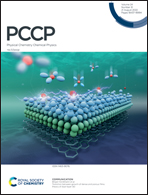Rational design of small molecule hole-transporting materials with a linear π-bridge for highly efficient perovskite solar cells†
Abstract
Developing highly efficient small molecule hole-transporting materials (HTMs) to improve the performance of devices is one of the hot topics in the progress of perovskite solar cells (PSCs). In this work, a series of molecules are designed by utilizing benzocyclobutadiene (C1), bicyclo[6.2.0]decapentaene (C2), naphthalene (C3), biphenylene (C4), fluorene (C5), and azulene (C6) as the π-cores, and p-methoxydiphenylamine (R1), p-methoxytriphenylamine (R2) and p-methoxydiphenylamine-substituted carbazole (R3) as the peripheral groups. For isolated molecules, frontier molecule orbitals, absorption and emission spectra, Stokes shift, stability, solubility, and hole mobility are assessed by density functional theory calculations along with the Marcus theory of electron transfer. The molecules adsorbed on the surface of CH3NH3PbI3 are used to simulate the interfacial properties between HTMs and perovskites. Our results indicate that varying the central bridge and the terminal groups has a remarkable influence on the properties. The designed R2-Cn (n = 3, 4, 5) have deeper HOMO levels, stronger absorption in the UV region, and larger Stokes shift than Spiro-OMeTAD. They also possess good solubility, stability, and hole mobility. The proper alignment of interfacial energy levels ensures the transfer of holes from CH3NH3PbI3 to the studied molecules and blocks the backflow of electrons simultaneously. Significant charge redistributions around the interfacial region benefit the separation and transfer photogenerated electron–hole pairs. The results of the present study can be further employed in the process of synthesizing new HTMs with promising features.



 Please wait while we load your content...
Please wait while we load your content...